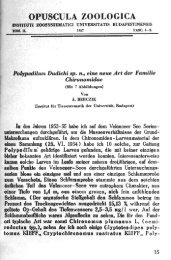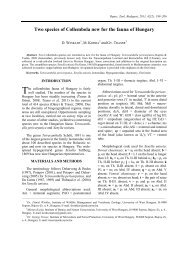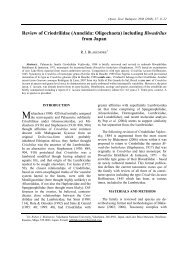1_ Acarol_lit.pdf - Opuscula Zoologica
1_ Acarol_lit.pdf - Opuscula Zoologica
1_ Acarol_lit.pdf - Opuscula Zoologica
You also want an ePaper? Increase the reach of your titles
YUMPU automatically turns print PDFs into web optimized ePapers that Google loves.
98<br />
Horváth, Kontschán & Mahunka: Hungarian acarological <strong>lit</strong>erature<br />
those works which were performed by Hungarian<br />
researchers although then that territory did not<br />
belong to Hungary (e.g. Balogh, 1943).<br />
To fully explore Hungarian applied acarological<br />
investigations and the pertaining <strong>lit</strong>erature is a<br />
rather tedious task. What means that owing to the<br />
incompetence of specialists we have declined to<br />
compile the whole <strong>lit</strong>erature of medical sciences<br />
(e.g. epidemiological, clinical), and we must admit<br />
that many valuable works are missing yet in<br />
the field of plant protection and veterinary sciences.<br />
We definitely wish to continue our venture<br />
for which any support extended we express our<br />
whole-hearted thanks.<br />
MATERIALS AND METHODS<br />
When delineating our project we had to fix<br />
some cornerstones. Thus we had to decide who is<br />
Hungarian and what we mean by the territory of<br />
Hungary.<br />
1. The works of “Hungarian” acarologists: in<br />
this group we relegated the persons whose nationna<strong>lit</strong>y<br />
is Hungarian. Irrespective of the country<br />
(the whole globe) they discussed in their publication.<br />
Papers published with foreign co-workers<br />
are also equivalent.<br />
2. The determination of the discussed territory<br />
(Hungary): presently we consider Hungary with<br />
the po<strong>lit</strong>ical boundaries of today. On the other<br />
hand, we have to include here all and every publication<br />
treating Hungarian faunal research, which<br />
had belonged to historical Hungary (i.e. the Carpathian<br />
Basin). However, as for example the paper<br />
of Willmann (1938) or that of Balogh (1943)<br />
will be included in the Hungarian <strong>lit</strong>erature. The<br />
work of Schalk (1965) or that of Kontschán<br />
(2008) or Mahunka & Mahunka-Papp (2008c) although<br />
treat Transylvanian (Romanian) material,<br />
specifically the latter two, because their Hungarian<br />
nationa<strong>lit</strong>y, are included in the present list.<br />
While collecting the present material, in all<br />
cases we endeavoured to obtain the original publiccation.<br />
Hard as we tried, we had been successful<br />
only in the taxonomical section, in other<br />
papers, in several cases we simply relied on <strong>lit</strong>erature<br />
references and the help of some colleagues.<br />
Although we planned to list all the taxa appearing<br />
in the <strong>lit</strong>erature for similar reasons we failed, for<br />
in many instances, species belonging to higher<br />
categories could not be identified. We had also<br />
been unable to stress some taxa or other important<br />
data (new species in the fauna, new distributional<br />
data, etc.).<br />
The gathered publications are presented according<br />
to authors listed alphabetically. The layout<br />
follows the references of the paper of Horváth<br />
as appeared in the Folia entomologica hungarica<br />
in 2004.<br />
The collecting, the checking, and the arrangement<br />
of the listed papers were primarily the work<br />
of the authors. However, without the help of all<br />
the acarologists working in Hungary our endeavour<br />
could not have been realized. We had a great<br />
deal of help from various specialists engaged in<br />
plant protection, in plant-protection acarology and<br />
even in veterinary science. In many instances<br />
these specialists helped us in evaluating and even<br />
supervising such publications. We should most<br />
sincerely like to thank them all.<br />
The colleagues who helped us are listed hereunder<br />
in alphabetical order: Sándor Bognár, Györffyné<br />
Júlia Molnár, Attila Haltrich, Gábor Jenser,<br />
Krisztina Mihályi, Nóra P. Zánkai, Jenő Ponyi,<br />
Géza Ripka, Tamásné Szemerey and Lászlóné<br />
Szendrey.<br />
LIST OF PUBLICATIONS<br />
Ábrahám, Géza<br />
ÁBRAHÁM, G. (1992): Study on acarids in peach orchards.<br />
– Acta Phytopathologica et Entomologica<br />
Hungarica, 27 (1-4): 35–37.<br />
— & PORCSA, I. (1990): A magtári atkakártevők<br />
jelentősége és a védekezési eljárások összehasonlítása.<br />
(Significance of mites in storehouses and the<br />
comparison of different control methods.) – Növényvédelem,<br />
26 (5): 208–209.<br />
GYÖRFFYNÉ MOLNÁR, J. & — (1990)<br />
Ábrahám, Rita<br />
ÁBRAHÁM, R. (2000): Különböző éréscsoportú szója<br />
fajták atka- és tripsznépessége. (Mite and thrips<br />
populations of soyabean varieties of different ripening<br />
groups.) – Növényvédelem, 36 (11): 583–589.<br />
— (2003): A közönséges takácsatka Tetranychus ur-





